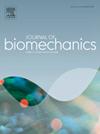Hemodynamic criteria for intimal tear in Type-B intramural hematoma of aorta based on patient-specific geometry
IF 2.4
3区 医学
Q3 BIOPHYSICS
引用次数: 0
Abstract
This study conducts hemodynamic simulations for a total of 20 patients with Type B aortic intramural hematoma (TBIMH) and aims to develop hemodynamic criteria for possible development of intimal tear and indicator for tearing location. The patients are divided into Group A without intimal tear and Group B with progression into tear. The mean oscillatory shear index is calculated based on the wall shear stress () distribution. The blood pressure drop along the main aortic vessel is calculated and the high pressure drop time fraction over one cardiac cycle is determined, with high pressure drop being defined as the pressure drop larger than half the maximal value. By combining and at low heart rates 60bpm and 75bpm, we reveal statistically significant correlation between no progression to tear and both low and low , with a pvalue of . We also propose a new parameter, namely the magnitude of tangential pressure gradient at aortic wall at the time when the pressure drop is maximal during one cardiac cycle. Comparison with CT imaging reveals that nine out of ten patients in Group B develop intimal tear at the location with elevated . Therefore, the current study provides a two-step procedure for the hemodynamic diagnosis of TBIMH. First, by combining and those patients with low risk of intimal tear can be excluded. Then, the location of elevated can be adopted as the indicator for possible intimal tear locations.
基于患者特异性几何结构的b型主动脉壁内血肿内膜撕裂的血流动力学标准
本研究对20例B型主动脉壁内血肿(Type B aortic intramural hematoma, TBIMH)患者进行血流动力学模拟,旨在建立可能发生内膜撕裂的血流动力学标准和撕裂位置指标。将患者分为无内膜撕裂的A组和进展为撕裂的B组。根据墙体剪应力(WSS¯)分布计算了平均振荡剪切指数OSI¯。计算沿主动脉血管的血压降,确定一个心动周期内的高压降时间分数Td/T,其中高压降定义为压降大于最大值的一半。通过结合低心率60bpm和75bpm时的OSI¯和Td/T,我们发现无撕裂进展与低OSI¯<;0.121和低Td/T<;0.067之间具有统计学意义的相关性,p值为p=8.7e−5。我们还提出了一个新的参数,即在一个心动周期内压降最大时主动脉壁切向压力梯度|∇τp|的大小。与CT影像比较,B组10例患者中有9例在|∇τp|升高部位发生内膜撕裂。因此,本研究提供了一种两步血流动力学诊断TBIMH的方法。首先,通过结合OSI¯和Td/T,可以排除那些低内膜撕裂风险的患者。然后,可以将升高的|∇τp|的位置作为可能的内膜撕裂位置的指标。
本文章由计算机程序翻译,如有差异,请以英文原文为准。
求助全文
约1分钟内获得全文
求助全文
来源期刊

Journal of biomechanics
生物-工程:生物医学
CiteScore
5.10
自引率
4.20%
发文量
345
审稿时长
1 months
期刊介绍:
The Journal of Biomechanics publishes reports of original and substantial findings using the principles of mechanics to explore biological problems. Analytical, as well as experimental papers may be submitted, and the journal accepts original articles, surveys and perspective articles (usually by Editorial invitation only), book reviews and letters to the Editor. The criteria for acceptance of manuscripts include excellence, novelty, significance, clarity, conciseness and interest to the readership.
Papers published in the journal may cover a wide range of topics in biomechanics, including, but not limited to:
-Fundamental Topics - Biomechanics of the musculoskeletal, cardiovascular, and respiratory systems, mechanics of hard and soft tissues, biofluid mechanics, mechanics of prostheses and implant-tissue interfaces, mechanics of cells.
-Cardiovascular and Respiratory Biomechanics - Mechanics of blood-flow, air-flow, mechanics of the soft tissues, flow-tissue or flow-prosthesis interactions.
-Cell Biomechanics - Biomechanic analyses of cells, membranes and sub-cellular structures; the relationship of the mechanical environment to cell and tissue response.
-Dental Biomechanics - Design and analysis of dental tissues and prostheses, mechanics of chewing.
-Functional Tissue Engineering - The role of biomechanical factors in engineered tissue replacements and regenerative medicine.
-Injury Biomechanics - Mechanics of impact and trauma, dynamics of man-machine interaction.
-Molecular Biomechanics - Mechanical analyses of biomolecules.
-Orthopedic Biomechanics - Mechanics of fracture and fracture fixation, mechanics of implants and implant fixation, mechanics of bones and joints, wear of natural and artificial joints.
-Rehabilitation Biomechanics - Analyses of gait, mechanics of prosthetics and orthotics.
-Sports Biomechanics - Mechanical analyses of sports performance.
 求助内容:
求助内容: 应助结果提醒方式:
应助结果提醒方式:


